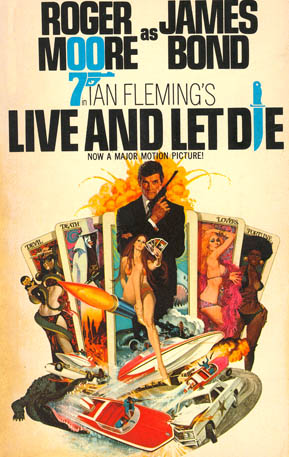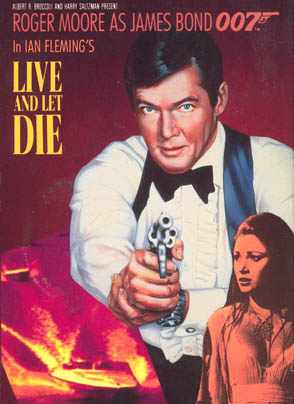 With the new James Bond movie Quantum of Solace about to be released in the fall, I decided to read some of the old James Bond novels that I didn’t get around to reading during my James Bond obsession in college. Back then, I was more interested in the action, so I started in the middle of the series with Dr. No and worked my way through Goldfinger, Thunderball, On Her Majesty’s Secret Service, You Only Live Twice, and Man with the Golden Gun. Later on I read Casino Royale (the first Bond novel), For Your Eyes Only, The Spy Who Loved Me, and Moonraker. Now, I feel the need to complete the series, so I started this summer with From Russia With Love and then Live and Let Die.
With the new James Bond movie Quantum of Solace about to be released in the fall, I decided to read some of the old James Bond novels that I didn’t get around to reading during my James Bond obsession in college. Back then, I was more interested in the action, so I started in the middle of the series with Dr. No and worked my way through Goldfinger, Thunderball, On Her Majesty’s Secret Service, You Only Live Twice, and Man with the Golden Gun. Later on I read Casino Royale (the first Bond novel), For Your Eyes Only, The Spy Who Loved Me, and Moonraker. Now, I feel the need to complete the series, so I started this summer with From Russia With Love and then Live and Let Die. Mind you, I bought all the Ian Fleming Bond books back in college, picking up different editions from various second-hand bookstores. The copy of Live and Let Die that I have is a movie tie-in from 1973. When I dusted off the old paperback and looked at that cover with the movie poster artwork, I was immediately transported to a summer 35 years earlier and my heart ached a bit from a sharp twinge of nostalgia. You see, Live and Let Die was the first James Bond movie I ever saw.
My family and I were in Wildwood, NJ that summer, as we had been for so many summers before and for several summers afterward. Ocean City, MD was closer to our home, but Wildwood, NJ had so much more to offer. I haven’t been there for many years, but the boardwalk in Wildwood seemed like a city unto itself when I was a kid. It went on for miles and featured pier after pier of rides and arcades. The boardwalk itself was studded with all manner of attractions, including nice sit-down restaurants and grand old one-screen movie theatres with giant marquees outside. It was in one of these theatres that I saw Live and Let Die.
This was a big moment for me because, not only was this the first James Bond film I had ever seen, this was the first grown-up action movie I had ever seen. For years, my brother Craig had been coming home from really cool movies like Bonnie and
But now it was the summer of 1973 and I was only one month away from turning nine years old. The glowing marquee on the boardwalk called out to me. I was well aware of James Bond, having listened the summer before as Craig described the exploits of the suave James Bond in Diamonds Are Forever. I also remembered seeing the Corgi version of that Moon Buggy from the film and knew that it had to have been one exciting flick. Now there was this new Bond film and I was determined to talk my parents into letting me see it. I knew my brother would help in the cajoling department, and the fact that we were on vacation in Wildwood always had a softening effect on my parents’ resolve. They decided it wasn’t such a bad way to spend the evening.
I can’t emphasize enough how much better the movie-going experience was back when you had large single-screen theatres as compared to the multiplexes of today. Since they only had one movie to show, the theatre made every effort to create an aura of excitement about the movie you were about to see. The multiplexes have every movie available in one place, so they put no effort into promoting anything. The lobbies all look the same and rather rinky-dink at that. Movie posters and standees are scattered haphazardly around where there is space. Their main interest is funneling you to the refreshment counter. Not so in the old days.
I remember standing in front of the theatre as my father stood in line to buy tickets. Not only did the flashing marquee scream that this was “the best Bond ever,” two huge, beautifully painted movie posters stood on either side of the box office. We’re talking boats crashing into cars, cars crashing into boats, boats crashing into boats, an alligator regurgitating a boat, guns, explosions, voodoo priests, sexy women in bikinis, and standing in the midst of all the mayhem was 007 himself, holding a really big gun! Of course, my brother made a point of lamenting the fact that Sean Connery was not playing James Bond anymore. It was now that prissy Saint guy, Roger Moore. This made no never mind to me, since I had never seen Sean Connery before. I liked The Saint. I even liked his show with Tony Curtis: The Persuaders. Roger Moore was okay with me. Plus, I liked how the poster artist incorporated the two “O’s” in Roger Moore’s name to spell out “007.” I thought perhaps the producers had hired Mr. Moore solely for that reason.
After getting the tickets, we walked inside and down a long hallway plastered with Bond posters and lobby cards. Seeing this hall of stills from the movie really got me jazzed. I was bursting at the seams before the movie started. Right away I was amazed at the fast-paced teaser, followed by the Paul McCartney theme song. Then we finally see Roger Moore himself in bed with a hot Italian chick. Cool! When he checked his digital watch (a very new invention in 1973), there was an audible gasp in the crowd. Little did we know that within one year we would all be wearing one (including me).
 By this time, the Bond films had developed a formula of their own very different from the formula of the novels. The movies had to have at least two Bond girls (the novels usually only had one), there had to be a plethora of chrome-shiny gadgets (the novels had few if any), and there had to be a long series of superfluous action set pieces to keep the audience entertained until Bond finally ended up at the villains hideout and commenced to blowing the place up. Because the producers were so compelled to stick with a proven formula, there’s very little in these later movies that relate to the books other than some characters, locales, and maybe a few actual scenes. In the case of Live and Let Die, the similarities include a Harlem crime boss named Mr. Big who uses his Haitian roots and voodoo as a weapon of intimidation, a smuggling pipeline running from Harlem to a state in the Deep South to a
By this time, the Bond films had developed a formula of their own very different from the formula of the novels. The movies had to have at least two Bond girls (the novels usually only had one), there had to be a plethora of chrome-shiny gadgets (the novels had few if any), and there had to be a long series of superfluous action set pieces to keep the audience entertained until Bond finally ended up at the villains hideout and commenced to blowing the place up. Because the producers were so compelled to stick with a proven formula, there’s very little in these later movies that relate to the books other than some characters, locales, and maybe a few actual scenes. In the case of Live and Let Die, the similarities include a Harlem crime boss named Mr. Big who uses his Haitian roots and voodoo as a weapon of intimidation, a smuggling pipeline running from Harlem to a state in the Deep South to a
I was surprised to discover that the scene in the movie where Bond is in a
Anyway, the movie was a real thrill ride for an eight-year-old. I was surprised at how familiar the situations felt, since by this time the silliness of the action set pieces in Bond films were not far from similar scenes in Disney movies. Also, the use of a Black Mafia felt similar to the Black Exploitation movies of the day, like Shaft and Superfly. As a white kid in the ‘burbs, I was fascinated by the previews for those films shown during episodes of Soul Train. They had the exotic allure of the forbidden. I could never go downtown to see movies like that, but with Live and Let Die, I felt like I was getting a taste of them.
The rest of the summer, I was obsessed with James Bond. The theme song was a hit on AM radio all through those summer months. I ran around the neighborhood playing James Bond. I even wrote secret agent stories about my own made up spy whose name escapes me. My brother and I stayed up at night debating who was a better Bond, Connery or
I’ve had an on-again, off-again relationship with James Bond ever since. My disappointment with Man with the Golden Gun caused me to miss The Spy Who Loved Me. I gave Bond another shot with Moonraker, and had my heart broken. For Your Eyes Only restored my faith in him, and even the goofy Octopussy hooked me on a reading spree of the old novels. I’ve seen every Bond movie in the theatre ever since, but their quality has been generally mediocre and, by the 90s, I wondered if there was any place for a character like Bond in our modern pop culture. Casino Royale proved to me that Bond could be revamped for the 21st century, and I’m back to reading Bond books again.



